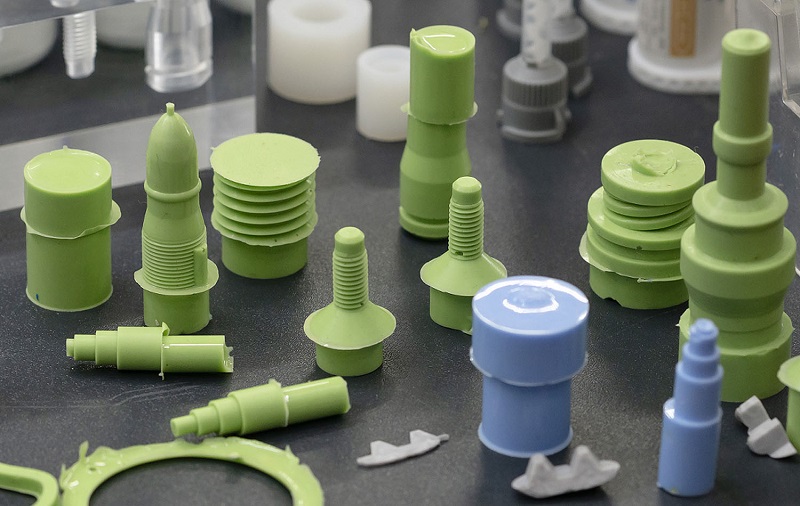There are various processes for rubber molding. This article mainly introduces 7 commonly used methods, analyzes their advantages and applications, and helps you better understand rubber molding.
1. Injection Molding
Rubber injection molding is also called injection molding. It is a production method that uses the pressure of the injection machine to inject the preheated rubber directly from the barrel through the nozzle into the mold cavity for forming, vulcanization, and setting.
Process flow:
Feeding→rubber softening and preheating→injection (injection)→vulcanization and setting→take out the product.
Advantage:
1. Continuity
2. Strict tolerances
3. Faster production time
4. High-cost performance
Application:
It is suitable for the production of large-scale, thick-walled, thin-walled, and complex geometric shapes, high-quality and high-yield rubber products.
Rubber injection machine equipment suppliers:
1. Netherlands VMI Company
2. French REP company
3. Italy RUTIL company
4. German DESMA company
5. German LWB Company
2. Compression Molding
Compression molding is putting the kneaded, processed into a certain shape, and weighed semi-finished rubber with certain plasticity directly into the open mold cavity. Then close the mold, send it into a flat vulcanizer to pressurize, heat, and keep it for a period of time. The rubber compound is vulcanized and formed under the action of heat and pressure.
Advantage:
1. Can produce more complex products
2. Fewer binding lines
3. Low processing cost
4. High production efficiency
5. Can handle high-hardness materials
Application:
It is suitable for the production of sealing rings, gaskets, and rubber products with inserts, such as handles, cloth tapes, tires, rubber shoes, etc.
Hydraulic press equipment supplier:
1. Zhengxi Hydraulic Equipment Co., Ltd.
2. Woda Heavy Industry Machinery
3. Transfer Molding
Transfer molding or extrusion molding. It is to put the semi-finished rubber strip or rubber block that has been kneaded, simple in shape, and limited in quantity into the cavity of the die-casting mold. The rubber is extruded by the pressure of the die-casting plug, and the rubber is vulcanized and finalized through the pouring system into the mold cavity.
Advantage:
1. Handle larger products
2. The high pressure inside the mold can do very detailed processing,
3. Rapid mold setting
4. High production efficiency
5. Low production cost
Application:
Especially suitable for large and complex, difficult-to-feed, thin-walled, and relatively precise rubber products with inserts.
Press equipment supplier:
1. Guangdong Yizumi Precision Machinery Co., Ltd.
2. Hefei Heforging Company
4. Extrusion Molding
Rubber extrusion molding is also called extrusion molding. It heats and plasticizes the rubber in the extruder (or extruder), pushes it forward continuously through the screw or plunger, and then extrudes it out of the molding die (referred to as the die) with the help of rubber. The process of extruding semi-finished products (profiles, moldings) of various required shapes to complete modeling or other operations.
Process features:
1. The texture of the semi-finished product is uniform and dense. Wide range of applications. The forming speed is fast, the work efficiency is high, the cost is low, and it is beneficial to automatic production.
2. The equipment occupies a small area, is light in weight, simple in structure, and low in cost. It can be operated continuously and has a large production capacity.
3. The mouth mold has a simple structure, easy processing, convenient disassembly and assembly, long service life, and easy storage and maintenance.
Application:
1. Prepare semi-finished products of tires, rubber shoes, rubber hoses, and other products.
2. Metal wire or wire, wire rope covered with glue, etc.
Extruder equipment supplier:
1. Troester, Germany
2. Krupp
3. Mitsubishi Heavy Industries
4. Kobe Machinery
5. Kobe Steel
6. Jinzhong Machinery
7. American Farrell
8. Davis Standard
5. Calendering Molding
6. Drum Vulcanizing Machine Forming (Tianjin Saixiang)
7. Vulcanization Tank Vulcanization Molding
After understanding the above 7 most common rubber molding processes, you can better use machines to manufacture your rubber products. If you need more information about compression molding machines, please contact us.
Post time: Apr-26-2023










